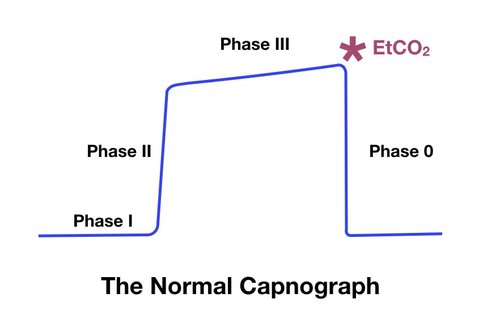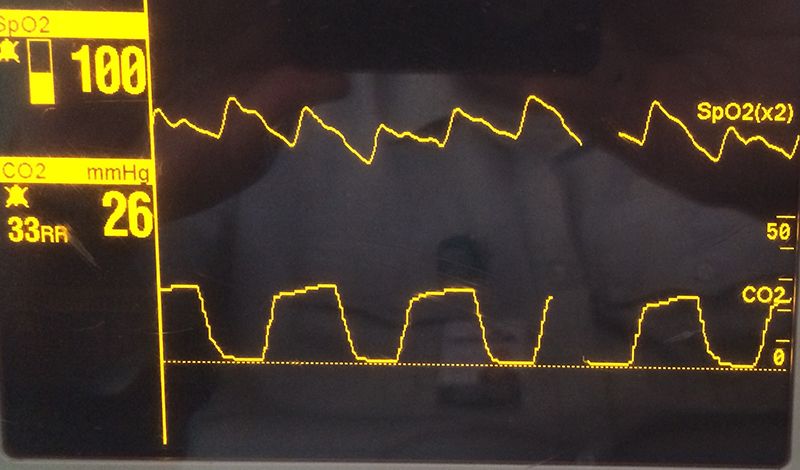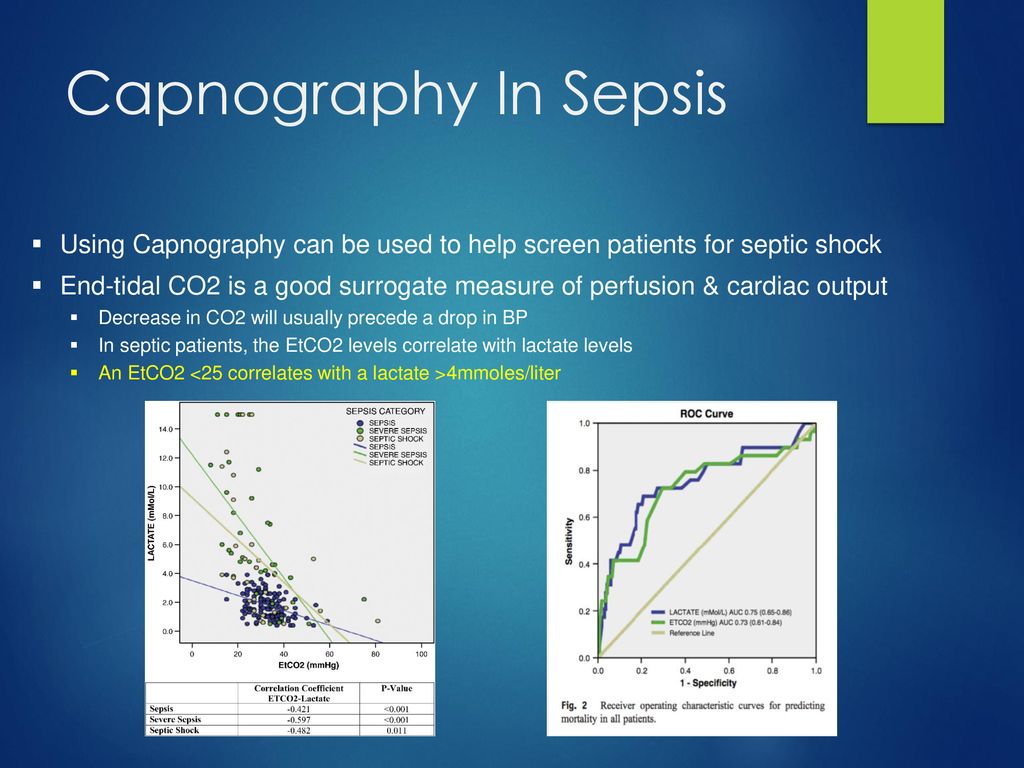low end tidal co2 sepsis
Dead-space ventilation results in ventilated alveoli with insufficient perfusion which leads to low ETco 2. EtCO2 levels decline in the setting of both poor perfusion and metabolic acidosis.

Evidence Supports Using End Tidal Carbon Dioxide To Detect Prehospital Sepsis Jems Ems Emergency Medical Services Training Paramedic Emt News
End-tidal capnography or end-tidal CO2 EtCO2 monitoring is a non-invasive technique that measures the partial pressure or maximal concentration of carbon dioxide CO2 at the end of an exhaled breath.

. Prior studies suggest exhaled end tidal carbon dioxide ETCO2 provides a non-invasive real-time method to screen for DKA in the emergency department ED. Low end tidal co2 sepsis This may result from such ventilatory problems as high mean airway pressure or inadequate exhalation time resulting in overdistention or fro. Monitoring End Tidal CO in critical care allows clinicians to assess how well the lungs are able to carry oxygen to the rest of the body which can provide clues about how the rest of the body is able to carry oxygen.
We were going to have an official Sepsis Alert until they discontinued the LactatePRO before we received them. This a retrospective cohort study among patients who activated Emergency Medical Services EMS during a one-year period. Now we just in-code with our findings and the hospital is usually smart enough to get the sepsis train going.
End-tidal carbon dioxide is associated with mortality and lactate in patients with suspected sepsis. As more research is done more and more uses are being found for this under utilized tool. P 001 severe sepsis AUC 080 95 CI 073-086.
End tidal CO 2 monitoring is represented as a number and a graph on a monitor. End tidal CO2 revealing a substantially low CO2 measurement also suggests hypocapnia eg etCO2. The normal values are 5-6 CO2 which is equivalent to 35-45 mmHg.
To compensate for metabolic acidosis patients increase their minute ventilation. There are four groups in this study. It has even been found that a low end tidal may be a symptom evident of sepsis along with many other criteria but thats for another blog.
However this may also be caused by pulmonary dysfunction with an increase in dead space volume. Cecal ligation and puncture CLP was used to cause severe sepsis in male SpragueDawley rats. P 001 and mortality AUC 070 95 CI 057-083.
P 001 and mortality AUC 070 95 CI 057-083. Severe sepsis is characterized by poor perfusion leading to a buildup of serum lactate and resulting metabolic acidosis. Why is end tidal CO2 low in sepsis.
Hotels in pasadena tx onspencer hwy. When EtCO is low with other signs of shock it indicates poor systemic perfusion which can be caused by hypovolemia sepsis or dysrhythmias. The waveform is called capnograph and shows how much CO 2 is present at each phase of the respiratory cycle.
How is end tidal CO2 measured. Seems like Orange County is behind the 8 ball a little bit with this whole ETCo2 in sepsis thing. Low ETCO 2 levels were the strongest predictor of sepsis area under the ROC curve AUC of 099 95 CI 099-100.
It has even been found that a low end tidal may be a symptom evident of sepsis along with many other criteria but thats for another blog. When ETCO2 is low with other signs of shock it indicates poor systemic perfusion which can be caused by hypovolemia sepsis or dysrhythmias. On the other hand a high co2 reading may indicate airway narrowing airway obstruction or respiratory distress.
Prehospital identification and initiation of therapy for severe sepsis may. Initial out-of-hospital vital signs documented by EMS. When CO2 diffuses out of the lungs into the exhaled air a device called a capnometer.
P 005 among all prehospital variables. In MAP group FR began when MAP at most 100 mmHg. Sham n 5 CLP n 10 end-tidal carbon dioxide ETCO 2 n 10 and mean arterial pressure MAP n 10In ETCO 2 group fluid resuscitation FR began when ETCO 2 at most 25 mmHg.
When a person suffers cardiac arrest there is no circulation metabolism or CO2 production. This may result from such ventilatory problems as high mean airway pressure or inadequate exhalation time resulting in overdistention or from such circulatory problems as. P 005 among all prehospital variables.
P 001 severe sepsis AUC 080 95 CI 073-086. Additionally low end-tidal carbon dioxide ETCO 2 levels have been associated with lactic acidosis organ dysfunction and mortality in ED patients with suspected sepsis. There is no mention of reduced end tidal co 2 e co2 in these definitions and it has always been presumed that low e co2 is a secondary sign of either a low perfusion state such as hypotension or severe bronchospasm.
End tidal CO 2 EtCO 2. Ad Learn more about the signs that may reveal you have an Issue that need attention. To compensate for metabolic acidosis patients increase their minute ventilation.
Sepsis alerts that followed the protocol had a sensitivity of 90 95 CI 81-95 a specificity of 58 95 CI 52. Those of you unfamiliar with waveform capnography may be confused by what I said in the last section. Previous studies have shown that low EtCO 2 levels correlate with elevated lactate levels and predict mortality in patients with suspected sepsis.
Only effective chest compressions can restore blood flow. The number is called capnometry which is the partial pressure of CO 2 detected at the end of exhalation ranging between 35 - 45 mm Hg or 40 57 kPa. End-tidal clearance must be evaluated in the context of the patients perfusion status.
Sepsis or septic shock is a serious condition that results from a bacterial infection. Low ETCO2 levels were the strongest predictor of sepsis area under the ROC curve AUC of 099 95 CI 099-100. Therefore correlation between the end tidal CO2 and an ABGVBG measurement is needed to confirm the diagnosis of hypocapnia.

How Capnography Can Be Used To Identify Sepsis

Advanced Concepts In Capnography Ppt Download
5 Medical Conditions Where Capnography Can Affect Bls Care Capnoacademy Capnoacademy

C Roc Curves For Predicting Severe Sepsis Auroc Area Under Receiver Download Scientific Diagram

A Systematic Approach To Capnography Waveforms Jems Ems Emergency Medical Services Training Paramedic Emt News

Sepsis Detection And Monitoring In Ems Bound Tree

Capnography Provides Bigger Physiological Picture To Maximize Patient Care Jems Ems Emergency Medical Services Training Paramedic Emt News

Potential Applications Of Capnography In The Prehospital Setting Journal Of Paramedic Practice

A Systematic Approach To Capnography Waveforms Jems Ems Emergency Medical Services Training Paramedic Emt News

Evidence Supports Using End Tidal Carbon Dioxide To Detect Prehospital Sepsis Jems Ems Emergency Medical Services Training Paramedic Emt News

Use End Tidal Carbon Dioxide To Diagnose Sepsis Jems Ems Emergency Medical Services Training Paramedic Emt News

C Roc Curves For Predicting Severe Sepsis Auroc Area Under Receiver Download Scientific Diagram

Exhaled End Tidal Carbon Dioxide As A Predictor Of Lactate And Pediatric Sepsis The American Journal Of Emergency Medicine

Abstract 320 End Tidal Carbon Dioxide Can Guide Fluid Resuscitation In A Cecal Ligation And Puncture Induced Rat Model Of Sepsis Circulation

End Tidal Carbon Dioxide Is Associated With Mortality And Lactate In Patients With Suspected Sepsis The American Journal Of Emergency Medicine

Jems Using Etco2 To Detect Sepsis Youtube

Etco2 To Identify Severe Sepsis Severe Sepsis Sepsis Nursing Education

6 Useful Sepsis Assessment And Treatment Tips Capnoacademy Capnoacademy